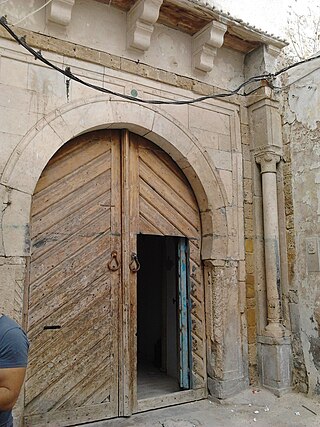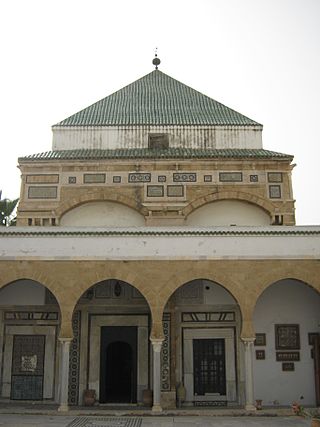
Dar Lasram is one of the palaces of the medina of Tunis. It is located at 24 Tribunal Street.

Dar Lasram is one of the palaces of the medina of Tunis. It is located at 24 Tribunal Street.
The Lasram's, an aristocratic family of Tunis, descend from a Yemeni tribe settled in Kairouan. It is composed of rich landowners. Most of them were ministers of the Pen (Arabic : وزارة القلم, French : ministres de la Plume ). [1] One of them, Hamouda Lasram, [2] is a rich landowner and a khawaja of the Igawawen tribe (secretary of Berber cavalry regiments).
In order to get a large plot and build the palace, he acquired and demolished several neighboring buildings. Its construction lasted from 1812 to 1819. [3]

Until the independence and the abolition of the habous, his descendants lived in the palace (which was considered inalienable as a habous).
In 1964, the municipality of Tunis acquired it. Four years later, in 1968, [4] it is allocated to the Association de sauvegarde de la médina de Tunis.
Dar Lasram, with a surface area of 2250 m2, [3] is a good example of a large traditional Tunisian residence. The ground floor contains the warehouse and the service area, the first floor is reserved to family members while the upper floor is reserved to guests.
Nowadays, the palace is divided between the Association de sauvegarde de la médina and the Tahar Haddad Club. [4]

The Museum of Marrakech is a historic palace and museum located in the old center of Marrakesh, Morocco. In addition to its notable architecture, the museum's collection showcases various historic art objects and contemporary art from Morocco.

The Bardo National Museum is a museum of Tunis, Tunisia, located in the suburbs of Le Bardo.

The Medina of Tunis is the medina quarter of Tunis, the capital of Tunisia. It has been a UNESCO World Heritage Site since 1979.
Hammuda Pasha Bey, died April 13, 1666 was the second Bey of the Tunisian Muradid dynasty. He reigned from 1631 until his death.
The Association de sauvegarde de la médina de Tunis was established in 1967 to conserve the Medina quarter in the old heart of Tunis. Its mission is "to strive for the conservation and protection of the overall traditional urban form of the Medina, its historical structures with all its distinctive elements and cultural heritage, and to take actions to ensure its preservation and enhancement."

Souq Al Bchamkiya is a former souk of the medina of Tunis, specialized in bechmak trading.

Madrasa Ennakhla ou Madrasa of the Palm is a former madrasa and one of the monuments of the Ottoman era in the medina of Tunis. It is named after the palm tree at the center of its patio which still stands today.
Dar Djellouli is an old palace of the medina of Tunis. It is located in the Street of the Rich in Bab Jedid, near Tourbet el Bey.

Dar Bayram is an old palace located in the Andalusians Street, in the medina of Tunis. It is indexed as one of the biggest historical residences of Tunis, in the inventory of Jacques Revault, member of the Middle East and Mediterranean Studies Research Group.

Dar Ben Ayed is an old palace of the medina of Tunis. It is located in the Ben Ayed Street in Bab Jedid, near Tourbet el Bey and Souk Es Sabbaghine.

Dar Bach Hamba is an old palace in the medina of Tunis.

Dar El Haddad is one of the oldest palaces in the medina of Tunis.

Dar Othman is one of the palaces of the medina of Tunis. The residence is located in the south of the medina, 16 El Mebazaâ Street.

Dar Hammuda Pasha is an old palace in the medina of Tunis. It is considered one of the oldest and biggest palaces of the medina that kept their original architecture.

Dar El Bey, also known as the government palace is an old palace in the medina of Tunis, more precisely in the city's Kasbah. Nowadays, it serves as the office of the Head of Government of Tunisia but was used by guests of the State previously. It is located south of Government Square, west of Kasbah Square.

The Sidi Kacem El Jellizi Mausoleum is a zaouia located on the edge of the medina of Tunis in Tunisia.

Dar Batḥa, or Qasr al-Batḥa, is a former royal palace in the city of Fez, Morocco. The palace was commissioned by the Alaouite Sultan Hassan I in the late 19th century and finished under his successor Abdelaziz. It was converted into a museum of historical arts and crafts in 1915 with a collection that now comprises over 6,500 objects. The palace is located near Bab Bou Jeloud at the western edge of Fes el-Bali, the old medina quarter of the city, and close to Fes el-Jdid, the new medina quarter. It is adjacent to the Dar el-Beida palace located to its southeast, which was originally part of the same complex.

Dar el Bacha is a palace located in the old medina of Marrakesh, Morocco. It currently houses the Museum of Confluences.

Dar Moqri is a historic palace or group of mansions in Fes el-Bali, the old medina of Fes, Morocco. It dates from the late 19th and early 20th centuries and was built by the wealthy and powerful Moqri family. The site is occupied by two grand residences built separately by members of the same family but physically adjoining each other. The older palace was begun by Abdelsalam al-Moqri and probably further modified by his son Muhammad. In addition to its rich interior, it is notable for its large terraced garden. The second palace belonged to his grandson Si Tayb and is notable for its long courtyard which mixes Italianate details with traditional Moroccan decoration. A completely separate palace, known as Riad Driss Moqri, was also built further north by Abdelsalam's son, Si Dris.

Traditional houses in Morocco are usually centered around a large internal courtyard, the wast ad-dar, and are characterized by a focus on interior decoration rather than on external appearance. The houses of wealthy residents featured decoration typical of Moroccan architecture and medieval Moorish architecture, including carved and painted wood, carved stucco, and zellij. The center of larger houses could also be occupied by a riad garden, particularly in places like Marrakesh where more space was available.